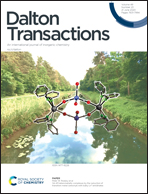Scandium bis(trimethylsilyl)methyl complexes revisited: extending the 45Sc NMR chemical shift range and a new structural motif of Li[CH(SiMe3)2]†
Abstract
Depending on the molar ratio employed, the reaction of ScCl3(thf)3 with Li[CH(SiMe3)2] afforded the bis and tris(alkyl) ate complexes [Sc{CH(SiMe3)2}2(μ-Cl)2Li(thf)2]2 and Sc[CH(SiMe3)2]3(μ-Cl)Li(thf)3, respectively, in moderate yields. Treatment of these mixed alkyl/chlorido complexes with MeLi gave the mixed alkyl complexes [Sc{CH(SiMe3)2}2(μ-Me)2Li(thf)2]2 and Sc[CH(SiMe3)2]3(μ-Me)Li(thf)3. Aiming at homoleptic {Sc[CH(SiMe3)2]3} both of the mixed [CH(SiMe3)2]/Me complexes were treated with AlMe3. Although LiAlMe4 separation occurred, aluminium complex Al[CH(SiMe3)2]Me2(thf) was the only isolable crystalline complex. Ate complexes [Sc{CH(SiMe3)2}2(μ-Me)2Li(thf)2]2 and [Sc(CH2SiMe3)4][Li(thf)4] revealed the maximum downfield 45Sc NMR chemical shifts of 888.0 and 933.4 ppm, respectively, reported to date. The synthesis of putative {Sc[CH(SiMe3)2]3} was also attempted via the aryloxide route applying complexes Sc(OC6H2tBu2-2,6-Me-4)3 and [Sc(OC6H3iPr2-2,6)3]2 along with Li[CH(SiMe3)2] but the outcome was inconclusive. Instead, a cyclic octamer was found for Li[CH(SiMe3)2] in the solid state.
![Graphical abstract: Scandium bis(trimethylsilyl)methyl complexes revisited: extending the 45Sc NMR chemical shift range and a new structural motif of Li[CH(SiMe3)2]](/en/Image/Get?imageInfo.ImageType=GA&imageInfo.ImageIdentifier.ManuscriptID=D0DT01247E&imageInfo.ImageIdentifier.Year=2020)


 Please wait while we load your content...
Please wait while we load your content...